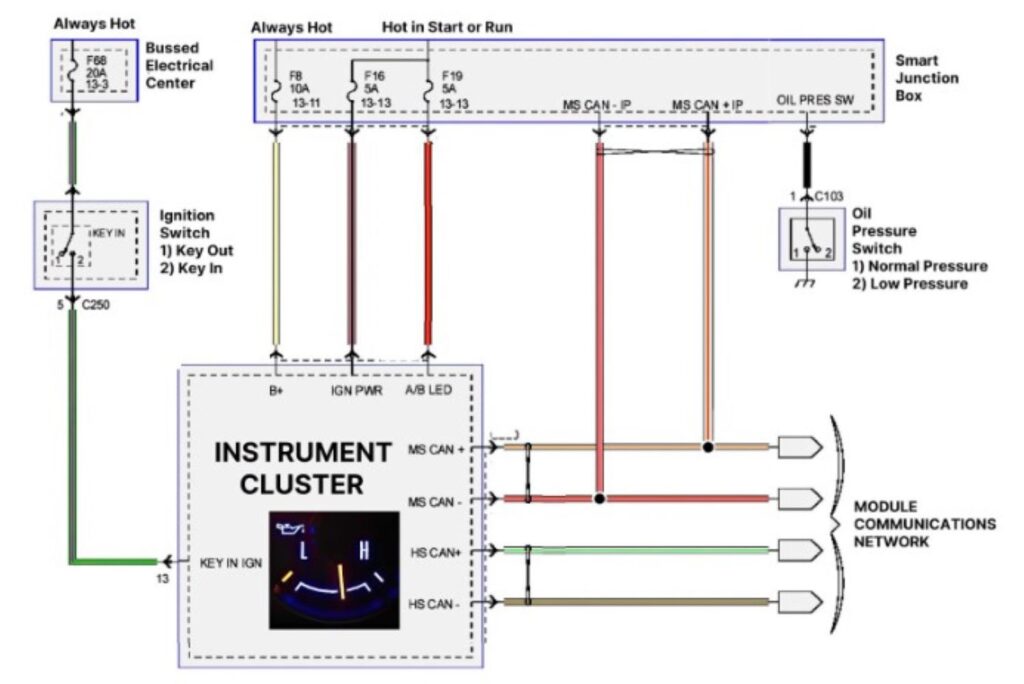The engine relies on oil pressure to move lubricant to all of its parts and areas that need cooling and greasing. Insufficient pressure will slow engine oil flow, leading to engine issues like overheating and premature wear. On the other hand, too much pressure can also interfere with the oil’s ability to enter bores leading to engine parts.
Fortunately, the oil pressure gauge lets you know about the pressure level inside the engine. Read on to learn vital things, like how to read an oil pressure gauge and the common symptoms of a bad gauge.

What Is the Oil Pressure Gauge?
The oil pressure gauge is a device that keeps track of the oil pressure in the engine. Some people drop the word pressure and refer to the device as the oil gauge.
That being said, not all oil pressure gauges read actual oil pressure. Fords, for example, will have a gauge that reads pressure but is actually driven by a sensor with only a switch. On later model Fords, this switch often reports to the smart junction box, which reports the oil pressure state (pressure or no pressure) to other modules such as the instrument cluster.

Almost all vehicles manufactured over the past 20 years have a computer built into the instrument cluster that receives oil pressure information from other modules. Older systems have a transducer that directly connects to the oil pressure gauge in the instrument cluster.
Almost all vehicles manufactured over the past 20 years have a computer built into the instrument cluster that receives oil pressure information from other modules. Older systems have a transducer that directly connects to the oil pressure gauge in the instrument cluster.
–Richard McCuistian, ASE Certified Master Automobile Technician
Most oil pressure gauges show a range of numbers, often 1-80 or 1-100. They also usually have a dial with an indicator needle that points at the lowest number when the engine isn’t running.
Some oil gauge models drop the numbers. Instead, they feature H and L, meaning high and low pressure, respectively, such as the Mustang schematic shown.
You can usually find the oil pressure gauge on your vehicle’s dashboard. It resembles other dashboard gauges, such as the speed and RPM indicators. Most oil gauges label themselves with “OIL” to make them easier to recognize.

Faulty Oil Gauge Symptoms
Most oil pressure gauges are not wear and tear items except on mid-2000s Chevy pickups, where the tiny servo that drives the gauge needle may fail, which is common with any or all of the gauges on those platforms.
Here are the most common indicators of a problem with the oil pressure gauge:
Oil Gauge Low
If the gauge is reading low, it’s best to err on the side of caution, check the oil, and have the engine oil pressure checked by a shop with a mechanical gauge.
As engine parts wear and oil pressure is lost through worn bearings (the oil gets thinner when it’s hot), the oil pressure might look acceptable when the engine is first started cold only to drop as the engine oil heats up. A good rule of thumb for acceptable minimum oil pressure is 10 psi per 1000 rpm. Optimum oil pressure would be from 40 to 60 psi with a hot engine.
Oil Gauge High
Does the oil pressure gauge show low-pressure readings while the engine idles? If the readings drop below 20 psi or stay in the gauge’s lower quarter, you might have a faulty oil gauge, but more importantly, you might have low engine oil pressure, which you should always have checked as soon as possible.
Pro Tip: Since many engines use oil pressure for their timing chain tensioners, low engine oil pressure may cause the timing chains to rattle. If you hear noise like this on a Dodge or a Ford, have the engine oil pressure checked by a shop.
A mechanical oil pressure gauge can develop a leak. Oil leaks reduce oil pressure, leading to the part showing inaccurately low readings.
For electric oil pressure gauges, issues with their wiring and other problematic components can affect the accuracy of their readings.
Oil Gauge Is Zero
If the oil gauge indicator needle stays at zero even though you can hear and feel the engine running without unusual noises, the sending unit can be checked by shorting the oil sender wire to ground (be careful not to damage the terminal) and watching the gauge to see if it responds to that ground. If it does, the sending unit might need replacing.
Usually, the oil pressure gauge will only show zero psi when the engine is turned off or idling unless there’s a problem with the sending unit, the gauge, the wiring or one of the modules that reports the oil pressure. When you start driving at higher speeds, the oil pump sends more lubricant through the system, which registers an increase in psi. If the needle doesn’t move from zero, the gauge might have stopped working.
Other reasons for the oil pressure gauge showing zero psi include a faulty oil pump or a low engine oil level.

Oil Pressure Gauge Types
You can divide oil gauges into two different types: electric gauges and mechanical gauges. Both types do the same job of showing the oil pressure in the engine, but they use different methods.
Mechanical Gauges
Older vehicles use mechanical oil pressure gauges. A mechanical gauge redirects engine oil into tiny pipes observed by an oil pressure sensor. The diverted oil has the same pressure as the lubricant flowing through the engine.
If one of its pipes develops a leak, the gauge will show oil pressure readings lower than reality. Engine oil will also escape the leak, which can deplete the oil levels prematurely and cause problems like overheating.
Aftermarket oil pressure gauges of the mechanical kind come with very small plastic tubing (usually ⅛). If you can get a gauge that will let you select the size of the line, use a ¼ inch line. Copper is good but plastic is okay as long as you run it so that it doesn’t chafe and begin to leak. Keep the line away from sharp edges and hot manifolds if you’re doing an aftermarket gauge install.
Electric Oil Gauges
There are 3 basic types of electric oil gauges: bimetal gauges, magnetic gauges, and computer-driven gauges.
Bimetal Gauges
Bimetal gauges have a strip that changes shape when it’s heated by a tiny wire connected to the sending unit. These disappeared beginning in the early 1970s and typically had a power feed through a special regulator built into the instrument cluster and a ground signal wire from the sending unit.
Magnetic Gauges
Magnetic gauges began to appear in the early 1970s. These gauges have two internal coils mounted at 90 degrees. Oil pressure gauges of this type have three wires: a ground, a power wire, and the signal wire from the sending unit.

Computer-driven Gauges
Computer-driven gauges sweep to their highest reading (with all the other gauges on the cluster) when the key is switched on as a proveout measure, and are driven by the internal instrument cluster computer.
What Does the Oil Pressure Gauge Do?
The oil gauge informs you about the current engine oil pressure, which is a good indicator of your engine’s health.
How to Read Oil Pressure Gauge
The oil pressure gauge starts at zero when the engine isn’t running. Its indicator needle will return to zero during idling.
It takes about 20 minutes of running the engine nonstop to normalize the oil pressure. Once the pressure stabilizes, the oil pressure gauge will move its indicator needle to the halfway mark.
If the oil gauge’s needle stays in the high or low range, something might have gone wrong with it or the engine.
What if your car’s oil pressure gauge reading shows H or L instead of numerical values? You don’t get the same precision, but you don’t need to memorize the recommended values.
Do you own a vehicle that doesn’t have an oil pressure gauge? Those models either provide a digital reading or put a light on the dashboard that illuminates and flickers when the oil pressure changes.
How to Get a Quality Oil Pressure Gauge
As we’ve mentioned, keeping an eye on your oil pressure is important if you want to avoid issues like overheating and premature engine wear. If your oil pressure gauge is malfunctioning, it’ll be difficult to tell if you need an oil top up. Thankfully, you can purchase a new oil gauge easily at CarParts.com.
The CarParts.com catalog contains many aftermarket brands to choose from. We sell high-quality replacement oil pressure gauges at various price points to suit different budgets. We also have a 60-day return policy in place to ensure that no matter which of our oil gauges you buy, it’ll be worth the investment. We even offer a lifetime replacement guarantee.
Don’t put up with a faulty oil pressure gauge. Purchase a new oil pressure gauge at CarParts.com today.
Any information provided on this Website is for informational purposes only and is not intended to replace consultation with a professional mechanic. The accuracy and timeliness of the information may change from the time of publication.

































